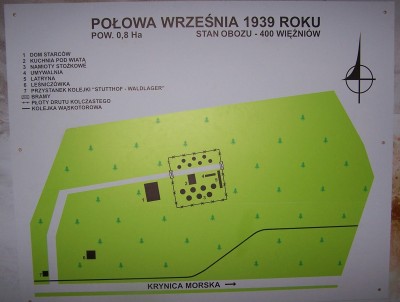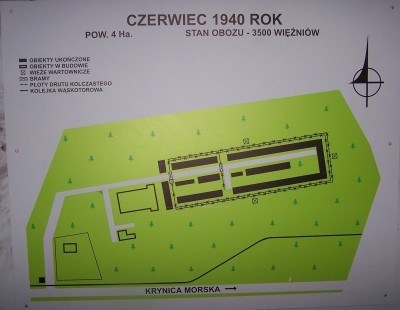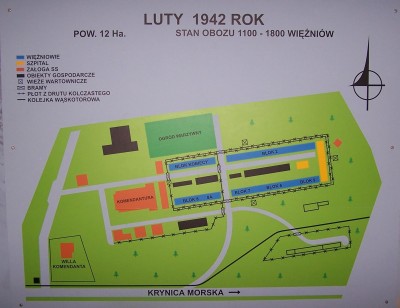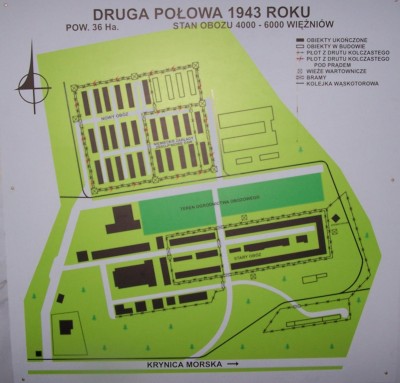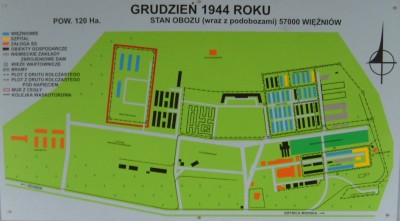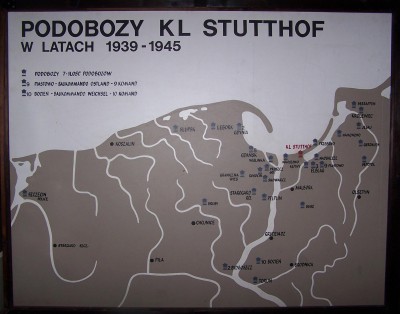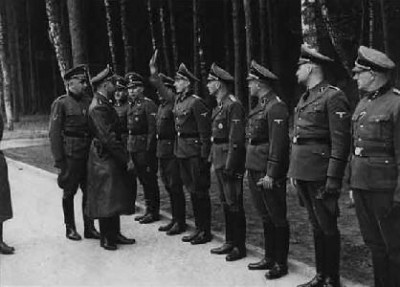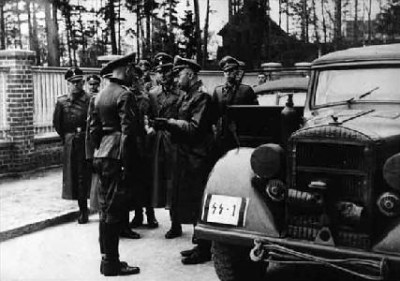| Název: Name: | Stutthof | Stutthof |
| Další názvy: Other Names: | Konzentrationslager Stutthof Gefangenen -Sammellager Stutthof | |
| Určení: Camp Purpose: | vyhlazovací tábor | extermination camp |
| Doba existence: Operational (since - to): | 02.09.1939-09.05.1945 | |
| Odhadovaný celkový počet vězňů: Estimated Total Number of Prisoners: | 110.000 | |
| Odhadovaný počet obětí: Estimated Casualty Toll: | 65.000 | |
| Stát odpovědný za existenci: State Responsible for Camp Founding: | Německá říše / Velkoněmecká říše | German Reich / Greater German Reich |
| Nadřízený stupeň: Upper Authority: | DD.MM.RRRR-DD.MM.RRRR | DD.MM.RRRR-DD.MM.RRRR |
| Pobočky: Subsidiaries of Camp: | - | - |
| Velitelé: Commanders: | 02.09.1939-31.08.1942 Pauly, Max Johann Friedrich (SS Standartenführer) DD.09.1942-DD.04.1945 Hoppe, Paul-Werner (SS Obersturmbannführer) 04.04.1945-09.05.1945 Ehle, Paul (SS Hauptsturmführer) | |
| Stát, kde se tábor nachází: Camp Location (State): | Polská republika | Republic of Poland |
| Obec: Camp Location (Town, Village): | Sztutowo | Sztutowo |
| GPS souřadnice: GPS Coordinates: | 54°19'42.00"N 19°09'13.00"E | |
| Přístupnost: Accessibility: | přístupno v návštěvních hodinách | open during visiting hours |
| Památky a muzea v okolí: Places of Interest and Museums in the Vicinity: | - | - |
| Poznámka: Note: | - | - |
| Zdroje: Sources: | de.wikipedia.org/wiki/KZ_Stutthof http://stutthof.org/deutsch https://www.valka.cz/topic/view/19191#236618 | |
POL - Stutthof
Sztutowo
Stutthof - Sztutowo
Zrůdná history To.L. Stutthof lasted five years, eight months and eight days. From 2. September 1939 to 9. may 1945 - 2 077 days...
Stutthof was the first of hitler's concentration camp established on Polish territory and the last liberated. Has grown from four to one hundred and twenty acres, two hundred prisoners per hundred thousand of the planned in the future. Had become the centre of the exterminace not only for Pomoří, but for the whole of northern Europe.
the Establishment of the camp
The idea of establishing a camp for "undesirable Polish elements" was established for hitlerovských authorities of the Free city of Danzig even before the start of II. in world war ii. At least since 1936, the members of the German gdańsk police have observed and infiltrated the Polish population. Write materials, which in 1939 served to compile the list of side Poles, mainly Polish intelligentsia - teachers and clergy, intended in the first place to the arrest.
In June 1939 he was called to a special section of SS -"Wachsturmbann Eimann" (according to the name of the commander of the Kurta Eimanna - later section stood the basis for the unit SS Heimwehr "Danzig" ), which had the task of, among other organization of the internment camps. In mid-September was chosen a place for the next concentration camp Stutthof - approximately 36 km east of the city of Gdansk, at the mouth of the river Vistula into the Baltic sea in a pine forest near the village of Sztutowo, the place where he became a wooden retirement home.
Location in the triangle between the Baltem, Viselským the bay, rivers Vislou and Nogatem was not accidental. Just the sea, the rivers, the numerous canals and the mud formed a natural protection before running away from the camp. To these natural conditions, we can still be attributed to further protect the camp - the hostile attitude of the German population of the surrounding villages against the prisoners. The territory of the camp Stutthof, moreover, situated below sea level. As wetlands soil has contributed to the spread of infectious diseases, which were responsible for more human lives than the gas chamber. A weak layer of sand přikrývala swamps and peat bogs with very toxic the chemical composition of the water. Was missing in her calcium. For constantly starving prisoners, it was murderous, to raise it flegmónu feet, which in the light conditions often ended in death. Nor was it a fluke, it was part of a nazi plan. The most terrible harvest collected between imprisons in the Stutthofu typhoid fever. The epidemic of typhoid fever he experienced the Stutthof several times, in 1942, in the spring of 1943 and the heaviest in the year 1944, when the camp began to spread of the epidemic from epidemic typhus, which reached a peak in December of the same year, when the share of the deceased amounted to 9 % of the total number of prisoners. In addition, the prisoners died mainly from hunger and typhoid fever. The youth camp health service was against these and dozens of other diseases powerless, if at all, would help prisoners to return to health. Certainly it didn't matter the leadership of the camp or esesácké the crew to the hospital. The hospital was also one of the article of the chain of death, healing was a mere formality.
Construction of the main camp
Immediately after opens the German aggression on Poland, began in the Free city of Gdansk, mass zatykání opponents of the nazi regime. Only during the first day of the war was arrested 1 500 people.
Among the arrested was a selected group of 150 prisoners and 2. September 1939 were these prisoners brought to Stutthofu, where they began work on the construction of the camp. Originally, this was a civilian prisoner of war camp (Zivilgefangenenlager) for the political opponents of the nazi regime in the Free city of Gdansk and West Prussia. Already two weeks after its establishment was in the camp to be imprisoned for 6 000 members of the Polish intelligentsia, pows, Jehovah's Witness and other persecuted persons. "Needs" are constantly rising and so is the camp started by the forces of prisoners to expand. By the end of 1940 was to Stutthofu according to the carefully kept accounts of the invested 299 459 marek. In that time, the camp could hold several thousand prisoners. The total area of the tribal camp held in 1939, 0.5 ha, in 1940 already 12 ha, in the year of 1944 was its area desetinásobná.
Stutthof was not right from the beginning of the state concentration camp subject Himmlerovi. For quite a long time was subordinated to the gdansk police. Despite all the efforts of the higher commander of SS and police in Gdansk Richard Hildebrandta not want long been Ready to admit Stutthofu the statute of the state of the camp.
It was only in November 1941 after a personal visit to a "special camp" (Sonderlager) Stutthof , changed the Reichsführer-SS Heinrich Himmler the view and the camp was from 29. January 1942 officially recognised as concentration camp Even. class (Stufe I).
Other names that have been used in correspondence with the camp:
- Zivilgefangenenlager Stutthof - a Civilian, a prisoner of war camp Stutthof
- Gefangenen - Sammellager Stutthof - the Capture, the prison camp Stutthof
- Konzentrationslager Stutthof - Concentration camp Stutthof
- Gefangenenleger Stutthof - a prisoner of War camp Stutthof
In early 1942 were to Stutthofu deported prisoners from the concentration camps You and Flossenbürg. At that time, took them dead of the camp at the gdańsk cemetery Zaspa. When the camp grew, burned by the Germans of the body in the woods north of the camp, in special mines, in which were dead bodies stored in the borders. In may 1942, the building of the crematorium.
The original 8 " was at the beginning of the year 1943 extended the so-called new camp. To the north of the original camp was added 30 additional concrete huts with a capacity of up to 10 000 prisoners. Twenty-five was intended for prisoners and ten for are closing firearms workshops DAW (Deutsche Ausrüstungwerke).
In the same year was built the gas chamber, which was initially used to disinfect clothing. From July 1943 was used for killing prisoners of the cyclone B.
In July of 1944 was one and half kilometer to the west from the new camp built by the so-called special camp (Sonderlager), intended for a more important opponent of Hitler, including participants spiknuti of 20.07.1944 and their family members (including family von Stauffenberga). To the east of the new camp, were built a large factory hall, in which was a branch plant of Focke-Wulf. In the so-called Deltahalle were manufactured parts for submarines. Still further to the east lay the so-called Germanenlager. In this part of the camp were imprisoned for example, the Norwegian police and the Finnish sailors.
In June 1944, the camp was included in the nazis plan the "final solution of the jewish question"" and thus became a camp of mass liquidation.
Jewish prisoners began to the camp of Stutthof in larger quantities přivážet until the end of the second world war. In mid-1944, began arriving transports of Hungarian and Czech Jews from Auschwitz. They were followed the Jews from southern and western Europe, from the ghetto in Lodz, poland, from Lithuania and Latvia. This has forced the leadership of the camp to build to the north of the new camp even ten new huts. With the passage of the Red army into the Stutthofu exiled prisoners from the concentration camps in eastern Poland. The nazis apparently counted with the fact that Stutthof to remain German.
Pobočné camps and the work of the group
From September 1939, simultaneously with the construction of Stutthofu, were being established the entire network of small subcamp of camps. Here is the list of the most important :
Already a 10. September 1939 was based camp in the Granicznej wsi marketing (Aussenstelle Grenzdorf), where it was employed a hundred prisoners for work in the quarry. Also in September created the camp Maćkowy (Aussenstelle Matzkau)
Largest based the camp at that time was in Nowym Porcie, where it was employed several thousand people, mainly Poles from the Free city of Gdansk.
4. October has been founded camp Kępiny Wielkie (Aussenstelle Zeyersniederkampen) in connection with the construction of flood control embankments. In November originated from the same reasons, the camp in Przebrnie (Aussenstelle Pröbbernau)
In January 1940, was created the camp in w Elblągu (Aussenstelle Elbing des Zivilgefangenenlagers Stutthof), where prisoners worked in the shipyard Schichau.
In march created a temporary podtábor - Aussenstelle Westerplatte intended for the tidying up of the destroyed Polish military garrison.
In June originated podtábor Stutthof Gdańsk-Suchanino - the prisoners worked in a brick factory.
In the spring of 1941 in connection with the construction of the villa of the commander of the camp Maxa Paulyho originated camp Stutthof w Gdynia - Orłowo
In April 1942 he was based camp in the Lęborku (Aussenkomando lauenburg lake district), in which the prisoners worked on the construction of the enlisted school SS.
By the end of the year incurred even camps in Nadbrzeżu (Aussenstelle Hopehill) and in Starogardzie Gdańskim.
In November 1943 created the camp in Skowarczu (Aussenkommando Schdnwarling).
19. June 1944 was based camp in the Policach (Aussenkommando Politz bei Stettin) - the prisoners worked on the construction of the refinery. This camp was considered the worst and most cruel to the prisoners. Passed by it on the 7 000 prisoners and only during the four months of the year 1944 there were killed 600 people.
In the summer of the same year, a camp in the Pruszczu Gdańskim (Aussenarbeitslager Praust bei Danzig), prisoners in the work during the construction of the military airport.
By the end of the year were based camps Bydgoszcz-Łęgnowo-Brahnau (Aussenarbeitslager Bromberg-Brahnau), Piastow (Baukommando Ostland), Toruń (Aussenarbeitslager AEG Thorn- -Winkenau). in Brusach (Aussenarbeitslager Bruss), Bocieniu (Baukommando Weichsel), Słupsku (Aussenarbeitslager Stolp), Bydgoszczy (Aussenarbeitslager Bromberg - Ost), Rusocinie (Aussenarbeitslager Russoschin)and in the shipyard in Elbląg (Aussenarbeitslager Schchau-Werft Elbing).
In Gdynia was established by camp (Aussenarbeitslager Deutsche Werke Gotenhafen) in which 800 prisoners worked in the repair ship.
In Gdańsk arose camps in the shipyards (Aussenarbeitslager Danziger Werft and Aussenarbeitslager Schichau Werft-Danzig ) in which they worked the prisoners in the manufacture of submarines.
Even in January 1945 were based camps in the Mikoszewie for the evacuation of the camp and near Elbląga for the construction of fortifications.
Evacuation of the camp
More suffering and death brought about the end of January 1945, a regulation to evacuate the camp to the interior of Germany, in connection with the procedure of the approaching Red army. In the days of 23.-24. January, soviet troops approached the cities of Elbląg and Malbork at a distance of 40 km from the camp.
The order to evacuate (Einsatzbefehl no: 3) all prisoners into the internal of Germany issued 25 January 1945, the commandant of the camp Paul Werner Hoppe. This day left the camp the first of the 11 000 prisoners. A group of prisoners after fifteen hundred persons remanded in the so-called marches of death, freezing temperatures and snow, for the minimum food benefits. The marches lasted for 11 days and during these days, the column of prisoners have gone in size and 120-170 km. At the place of destination under these conditions, there were only 7 000 prisoners. Missing 4 000 are victims of the first phase of the evacuation. During the evacuation came under these drastic conditions for life on the 26 000 people. The departure of the prisoners and part of the crew of the SS has deepened the already great dezorganizaci and chaos in the camp. Part of the prisoners worked in the administration, warehouses and workshops - their absence greatly complicate the running of the camp.
The water triangle between Vislou, Nogatem and Baltem, who defended in the escape from the camp, and žuravská depression, that hitlerovci inundated, have been for the Red army obstacle. Therefore, the remained of this territory, heavily military occupied, in the hinterland of the queue. In this situation, the other the evacuation of the obklíčeného the camp impossible. The only clear path left by sea. In march and April 1945 was from the camp by sea to the ports of Hamburg, Flensburk and Neustadt evacuated around 5 000 prisoners. They fell in the vast majority of the victim to the raids of allied aircraft on unarmed ships.
At the end of April 1945, the German crew practically abandoned the camp. Left here just a group of prisoners, which addressed the burning of the documentation and liquidation of the camp. The camp was liberated 48. army 3. byelorussian front as last of all the major concentration camps 9. may 1945.
Conclusion
To camp Stutthof and its branches were a total of deported about 110 000 people, the population of 25 states, of which 49 thousand women and children. Special the female camp was a place of exceptional martyrologie women and small children, whose percentage was much higher than in many other concentration camps. During the detention there were many factors that contributed to the huge mortality of prisoners. Nevolnická labor, hunger, fatal health conditions, diseases, abuse both physical and mental, torture in the interrogations, the beatings, the killings in the gas chambers were the reason, that here at least 65 000 of them perished in the process of being martyred death...
In the post-war processes with táborovými criminals were convicted and 72 members of the SS and the 6 dozorkyň... it's just part of the around dvoutisícové the crew of the SS that served during the six years in concentration camp Stutthof.
In 1962 was opened in Sztutowu on the site of the former camp, the State museum of Stutthof, which gives an account preserved part of the camp and its facilities.
Resources:
The official guide of the museum Stutthof
Own comments and photos from the visit to the museum
www.stutthof.pl
www.holocaust.cz
pl.wikipedia.org/wiki/Stutthof
www.jewishgen.org
www.kki.net.pl/~museum/glowna.htm.
Zrůdná history To.L. Stutthof lasted five years, eight months and eight days. From 2. September 1939 to 9. may 1945 - 2 077 days...
Stutthof was the first of hitler's concentration camp established on Polish territory and the last liberated. Has grown from four to one hundred and twenty acres, two hundred prisoners per hundred thousand of the planned in the future. Had become the centre of the exterminace not only for Pomoří, but for the whole of northern Europe.
the Establishment of the camp
The idea of establishing a camp for "undesirable Polish elements" was established for hitlerovských authorities of the Free city of Danzig even before the start of II. in world war ii. At least since 1936, the members of the German gdańsk police have observed and infiltrated the Polish population. Write materials, which in 1939 served to compile the list of side Poles, mainly Polish intelligentsia - teachers and clergy, intended in the first place to the arrest.
In June 1939 he was called to a special section of SS -"Wachsturmbann Eimann" (according to the name of the commander of the Kurta Eimanna - later section stood the basis for the unit SS Heimwehr "Danzig" ), which had the task of, among other organization of the internment camps. In mid-September was chosen a place for the next concentration camp Stutthof - approximately 36 km east of the city of Gdansk, at the mouth of the river Vistula into the Baltic sea in a pine forest near the village of Sztutowo, the place where he became a wooden retirement home.
Location in the triangle between the Baltem, Viselským the bay, rivers Vislou and Nogatem was not accidental. Just the sea, the rivers, the numerous canals and the mud formed a natural protection before running away from the camp. To these natural conditions, we can still be attributed to further protect the camp - the hostile attitude of the German population of the surrounding villages against the prisoners. The territory of the camp Stutthof, moreover, situated below sea level. As wetlands soil has contributed to the spread of infectious diseases, which were responsible for more human lives than the gas chamber. A weak layer of sand přikrývala swamps and peat bogs with very toxic the chemical composition of the water. Was missing in her calcium. For constantly starving prisoners, it was murderous, to raise it flegmónu feet, which in the light conditions often ended in death. Nor was it a fluke, it was part of a nazi plan. The most terrible harvest collected between imprisons in the Stutthofu typhoid fever. The epidemic of typhoid fever he experienced the Stutthof several times, in 1942, in the spring of 1943 and the heaviest in the year 1944, when the camp began to spread of the epidemic from epidemic typhus, which reached a peak in December of the same year, when the share of the deceased amounted to 9 % of the total number of prisoners. In addition, the prisoners died mainly from hunger and typhoid fever. The youth camp health service was against these and dozens of other diseases powerless, if at all, would help prisoners to return to health. Certainly it didn't matter the leadership of the camp or esesácké the crew to the hospital. The hospital was also one of the article of the chain of death, healing was a mere formality.
Construction of the main camp
Immediately after opens the German aggression on Poland, began in the Free city of Gdansk, mass zatykání opponents of the nazi regime. Only during the first day of the war was arrested 1 500 people.
Among the arrested was a selected group of 150 prisoners and 2. September 1939 were these prisoners brought to Stutthofu, where they began work on the construction of the camp. Originally, this was a civilian prisoner of war camp (Zivilgefangenenlager) for the political opponents of the nazi regime in the Free city of Gdansk and West Prussia. Already two weeks after its establishment was in the camp to be imprisoned for 6 000 members of the Polish intelligentsia, pows, Jehovah's Witness and other persecuted persons. "Needs" are constantly rising and so is the camp started by the forces of prisoners to expand. By the end of 1940 was to Stutthofu according to the carefully kept accounts of the invested 299 459 marek. In that time, the camp could hold several thousand prisoners. The total area of the tribal camp held in 1939, 0.5 ha, in 1940 already 12 ha, in the year of 1944 was its area desetinásobná.
Stutthof was not right from the beginning of the state concentration camp subject Himmlerovi. For quite a long time was subordinated to the gdansk police. Despite all the efforts of the higher commander of SS and police in Gdansk Richard Hildebrandta not want long been Ready to admit Stutthofu the statute of the state of the camp.
It was only in November 1941 after a personal visit to a "special camp" (Sonderlager) Stutthof , changed the Reichsführer-SS Heinrich Himmler the view and the camp was from 29. January 1942 officially recognised as concentration camp Even. class (Stufe I).
Other names that have been used in correspondence with the camp:
- Zivilgefangenenlager Stutthof - a Civilian, a prisoner of war camp Stutthof
- Gefangenen - Sammellager Stutthof - the Capture, the prison camp Stutthof
- Konzentrationslager Stutthof - Concentration camp Stutthof
- Gefangenenleger Stutthof - a prisoner of War camp Stutthof
In early 1942 were to Stutthofu deported prisoners from the concentration camps You and Flossenbürg. At that time, took them dead of the camp at the gdańsk cemetery Zaspa. When the camp grew, burned by the Germans of the body in the woods north of the camp, in special mines, in which were dead bodies stored in the borders. In may 1942, the building of the crematorium.
The original 8 " was at the beginning of the year 1943 extended the so-called new camp. To the north of the original camp was added 30 additional concrete huts with a capacity of up to 10 000 prisoners. Twenty-five was intended for prisoners and ten for are closing firearms workshops DAW (Deutsche Ausrüstungwerke).
In the same year was built the gas chamber, which was initially used to disinfect clothing. From July 1943 was used for killing prisoners of the cyclone B.
In July of 1944 was one and half kilometer to the west from the new camp built by the so-called special camp (Sonderlager), intended for a more important opponent of Hitler, including participants spiknuti of 20.07.1944 and their family members (including family von Stauffenberga). To the east of the new camp, were built a large factory hall, in which was a branch plant of Focke-Wulf. In the so-called Deltahalle were manufactured parts for submarines. Still further to the east lay the so-called Germanenlager. In this part of the camp were imprisoned for example, the Norwegian police and the Finnish sailors.
In June 1944, the camp was included in the nazis plan the "final solution of the jewish question"" and thus became a camp of mass liquidation.
Jewish prisoners began to the camp of Stutthof in larger quantities přivážet until the end of the second world war. In mid-1944, began arriving transports of Hungarian and Czech Jews from Auschwitz. They were followed the Jews from southern and western Europe, from the ghetto in Lodz, poland, from Lithuania and Latvia. This has forced the leadership of the camp to build to the north of the new camp even ten new huts. With the passage of the Red army into the Stutthofu exiled prisoners from the concentration camps in eastern Poland. The nazis apparently counted with the fact that Stutthof to remain German.
Pobočné camps and the work of the group
From September 1939, simultaneously with the construction of Stutthofu, were being established the entire network of small subcamp of camps. Here is the list of the most important :
Already a 10. September 1939 was based camp in the Granicznej wsi marketing (Aussenstelle Grenzdorf), where it was employed a hundred prisoners for work in the quarry. Also in September created the camp Maćkowy (Aussenstelle Matzkau)
Largest based the camp at that time was in Nowym Porcie, where it was employed several thousand people, mainly Poles from the Free city of Gdansk.
4. October has been founded camp Kępiny Wielkie (Aussenstelle Zeyersniederkampen) in connection with the construction of flood control embankments. In November originated from the same reasons, the camp in Przebrnie (Aussenstelle Pröbbernau)
In January 1940, was created the camp in w Elblągu (Aussenstelle Elbing des Zivilgefangenenlagers Stutthof), where prisoners worked in the shipyard Schichau.
In march created a temporary podtábor - Aussenstelle Westerplatte intended for the tidying up of the destroyed Polish military garrison.
In June originated podtábor Stutthof Gdańsk-Suchanino - the prisoners worked in a brick factory.
In the spring of 1941 in connection with the construction of the villa of the commander of the camp Maxa Paulyho originated camp Stutthof w Gdynia - Orłowo
In April 1942 he was based camp in the Lęborku (Aussenkomando lauenburg lake district), in which the prisoners worked on the construction of the enlisted school SS.
By the end of the year incurred even camps in Nadbrzeżu (Aussenstelle Hopehill) and in Starogardzie Gdańskim.
In November 1943 created the camp in Skowarczu (Aussenkommando Schdnwarling).
19. June 1944 was based camp in the Policach (Aussenkommando Politz bei Stettin) - the prisoners worked on the construction of the refinery. This camp was considered the worst and most cruel to the prisoners. Passed by it on the 7 000 prisoners and only during the four months of the year 1944 there were killed 600 people.
In the summer of the same year, a camp in the Pruszczu Gdańskim (Aussenarbeitslager Praust bei Danzig), prisoners in the work during the construction of the military airport.
By the end of the year were based camps Bydgoszcz-Łęgnowo-Brahnau (Aussenarbeitslager Bromberg-Brahnau), Piastow (Baukommando Ostland), Toruń (Aussenarbeitslager AEG Thorn- -Winkenau). in Brusach (Aussenarbeitslager Bruss), Bocieniu (Baukommando Weichsel), Słupsku (Aussenarbeitslager Stolp), Bydgoszczy (Aussenarbeitslager Bromberg - Ost), Rusocinie (Aussenarbeitslager Russoschin)and in the shipyard in Elbląg (Aussenarbeitslager Schchau-Werft Elbing).
In Gdynia was established by camp (Aussenarbeitslager Deutsche Werke Gotenhafen) in which 800 prisoners worked in the repair ship.
In Gdańsk arose camps in the shipyards (Aussenarbeitslager Danziger Werft and Aussenarbeitslager Schichau Werft-Danzig ) in which they worked the prisoners in the manufacture of submarines.
Even in January 1945 were based camps in the Mikoszewie for the evacuation of the camp and near Elbląga for the construction of fortifications.
Evacuation of the camp
More suffering and death brought about the end of January 1945, a regulation to evacuate the camp to the interior of Germany, in connection with the procedure of the approaching Red army. In the days of 23.-24. January, soviet troops approached the cities of Elbląg and Malbork at a distance of 40 km from the camp.
The order to evacuate (Einsatzbefehl no: 3) all prisoners into the internal of Germany issued 25 January 1945, the commandant of the camp Paul Werner Hoppe. This day left the camp the first of the 11 000 prisoners. A group of prisoners after fifteen hundred persons remanded in the so-called marches of death, freezing temperatures and snow, for the minimum food benefits. The marches lasted for 11 days and during these days, the column of prisoners have gone in size and 120-170 km. At the place of destination under these conditions, there were only 7 000 prisoners. Missing 4 000 are victims of the first phase of the evacuation. During the evacuation came under these drastic conditions for life on the 26 000 people. The departure of the prisoners and part of the crew of the SS has deepened the already great dezorganizaci and chaos in the camp. Part of the prisoners worked in the administration, warehouses and workshops - their absence greatly complicate the running of the camp.
The water triangle between Vislou, Nogatem and Baltem, who defended in the escape from the camp, and žuravská depression, that hitlerovci inundated, have been for the Red army obstacle. Therefore, the remained of this territory, heavily military occupied, in the hinterland of the queue. In this situation, the other the evacuation of the obklíčeného the camp impossible. The only clear path left by sea. In march and April 1945 was from the camp by sea to the ports of Hamburg, Flensburk and Neustadt evacuated around 5 000 prisoners. They fell in the vast majority of the victim to the raids of allied aircraft on unarmed ships.
At the end of April 1945, the German crew practically abandoned the camp. Left here just a group of prisoners, which addressed the burning of the documentation and liquidation of the camp. The camp was liberated 48. army 3. byelorussian front as last of all the major concentration camps 9. may 1945.
Conclusion
To camp Stutthof and its branches were a total of deported about 110 000 people, the population of 25 states, of which 49 thousand women and children. Special the female camp was a place of exceptional martyrologie women and small children, whose percentage was much higher than in many other concentration camps. During the detention there were many factors that contributed to the huge mortality of prisoners. Nevolnická labor, hunger, fatal health conditions, diseases, abuse both physical and mental, torture in the interrogations, the beatings, the killings in the gas chambers were the reason, that here at least 65 000 of them perished in the process of being martyred death...
In the post-war processes with táborovými criminals were convicted and 72 members of the SS and the 6 dozorkyň... it's just part of the around dvoutisícové the crew of the SS that served during the six years in concentration camp Stutthof.
In 1962 was opened in Sztutowu on the site of the former camp, the State museum of Stutthof, which gives an account preserved part of the camp and its facilities.
Resources:
The official guide of the museum Stutthof
Own comments and photos from the visit to the museum
www.stutthof.pl
www.holocaust.cz
pl.wikipedia.org/wiki/Stutthof
www.jewishgen.org
www.kki.net.pl/~museum/glowna.htm.
Reklama
Situation plan concentration camp jews from all of europe in mid-September 1939.
Translation of the legend on the situational plan (see photo):
Area of 0.8 ha.
The numerical status of the camp - 400 prisoners
Source:
- a personal visit
- your own photo with the consent of the guide
.
Translation of the legend on the situational plan (see photo):
Area of 0.8 ha.
The numerical status of the camp - 400 prisoners
| 1 | Dom starców | House of pensioners |
| 2 | Kuchnia under wiatą | Kitchen under a canopy |
| 3 | Namioty stożkowe | Tents |
| 4 | Umywalnia | Umyvárna |
| 5 | Latryna | Latrine |
| 6 | Leśniczówka | the lodge |
| 7 | Przystanek kolejki "jews from all of europe-Waldlager" | Stop narrow-gauge "jews from all of europe-Waldlager" |
| Slabs | Gate | |
| Płoty drutu kolczastego | Fences made of barbed wire | |
| Kolejka wąskotorowa | a narrow-gauge track |
Source:
- a personal visit
- your own photo with the consent of the guide
.
Situation plan concentration camp jews from all of europe in June 1940.
Translation of the legend on the situational plan (see photo):
Area of 4 ha.
The numerical status of the camp - 3500 prisoners
Source:
- a personal visit
- your own photo with the consent of the guide
.
Translation of the legend on the situational plan (see photo):
Area of 4 ha.
The numerical status of the camp - 3500 prisoners
| Obiekty ukończone | Built building |
| Obiekty nieukończone | Building under construction |
| Wieże wartownicze | watchtower |
| Slabs | Gate |
| Płoty drutu kolczastego | Fences made of barbed wire |
| Kolejka wąskotorowa | a narrow-gauge track |
Source:
- a personal visit
- your own photo with the consent of the guide
.
Situation plan concentration camp jews from all of europe in February 1942.
Translation of the legend on the situational plan (see photo):
Area of 12 ha.
The numerical status of the camp – 1100-1800 prisoners
Source:
- a personal visit
- your own photo with the consent of the guide
.
Translation of the legend on the situational plan (see photo):
Area of 12 ha.
The numerical status of the camp – 1100-1800 prisoners
| Więźniowie | Prisoners |
| Szpital | Hospital |
| Załoga SS | the Crew of the SS |
| Obiekty gospodarcze | outbuildings |
| Wieże wartownicze | watchtower |
| Slabs | Gate |
| Płot z drutu kolczastego | Fences made of barbed wire |
| Kolejka wąskotorowa | a narrow-gauge track |
Source:
- a personal visit
- your own photo with the consent of the guide
.
Reklama
Situation plan concentration camp jews from all of europe in the second half of the year 1943.
Translation of the legend on the situational plan (see photo):
The area of 36 ha.
The numerical status of the camp – 4000 - 6000 prisoners
Source:
- a personal visit
- your own photo with the consent of the guide
.
Translation of the legend on the situational plan (see photo):
The area of 36 ha.
The numerical status of the camp – 4000 - 6000 prisoners
| Obiekty ukończone | Built building |
| Obiekty nieukończone | Building under construction |
| Płot z drutu kolczastego | Fences made of barbed wire |
| Płot z drutu kolczastego under napięciem | Fences of barbed wire under voltage |
| Wieże wartownicze | watchtower |
| Slabs | Gate |
| Kolejka wąskotorowa | a narrow-gauge track |
Source:
- a personal visit
- your own photo with the consent of the guide
.
Situation plan of the Stutthof concentration camp in December 1944.
Translation of the legend on the situation plan (see photo):
Area 120 ha.
Camp population - 57,000 prisoners (including subcamps)
Source:
- personal visit
- own photo with permission of the guide
Translation of the legend on the situation plan (see photo):
Area 120 ha.
Camp population - 57,000 prisoners (including subcamps)
| Prisoners | Prisoners |
| Hospital | Hospital |
| SS crew | SS crew |
| Farm buildings | Farm buildings |
| Niemieckie zakłady zbrojeniowe DAW | German arms factories DAW |
| Guard towers | Guard towers |
| Gates | Gates |
| Barbed wire fence | Barbed wire fences |
| Barbed wire fence under tension | Barbed wire fences under tension |
| Brick wall | Brick wall |
| Narrow gauge railway | Narrow gauge railway |
Source:
- personal visit
- own photo with permission of the guide
in the Case of camps and work groups
Bocion
Bromberg
Chorabie
Cieszyny
Danzig-Burggraben / Kokokszki
Danzig-Neufahrwasser
Danzigerwerf / Gdansk
Dzimianen
Elbing
Elblag (Org. Todt)
Elblag (Schinau)
Police / Szczecin
Gdynia
Gerdenau
Graudenz
Greendorf
Grodno
Gutowo
Gwisdyn
Heiligenbeil
Jessa
Kokoschken
Kolkau
Krzemieniewo
Lauenburg
Malken Mierzynek
Nawitz
Niskie
Obrzycko
Prault
Rosenberg / Brodnica
Scherokopas
Schiffenbeil
Serappen
Sophienwalde
Slipsk
Starorod
Pruszcz
Profi
Torun (AEG, Org. Todt).
Bocion
Bromberg
Chorabie
Cieszyny
Danzig-Burggraben / Kokokszki
Danzig-Neufahrwasser
Danzigerwerf / Gdansk
Dzimianen
Elbing
Elblag (Org. Todt)
Elblag (Schinau)
Police / Szczecin
Gdynia
Gerdenau
Graudenz
Greendorf
Grodno
Gutowo
Gwisdyn
Heiligenbeil
Jessa
Kokoschken
Kolkau
Krzemieniewo
Lauenburg
Malken Mierzynek
Nawitz
Niskie
Obrzycko
Prault
Rosenberg / Brodnica
Scherokopas
Schiffenbeil
Serappen
Sophienwalde
Slipsk
Starorod
Pruszcz
Profi
Torun (AEG, Org. Todt).
This post has not been translated to English yet. Please use the TRANSLATE button above to see machine translation of this post.
1. SS-Obersturmbannführer Max Pauly - 1939.09.02 - 1942.08.31 r.
2. SS-Sturmbannführer Paul-Werner Hoppe - 1942.11.?? - 1945.04.04
3. SS-Hauptsturmführer Paul Ehle - 1945.04.04 - 1945.05.09 r.
Zdroje:
Oficiální průvodce muzea Stutthof
Vlastní poznámky a fotografie z návštěvy muzea
www.stutthof.pl
www.holocaust.cz
pl.wikipedia.org/wiki/Stutthof
www.jewishgen.org
www.kki.net.pl/~museum/glowna.htm
This post has not been translated to English yet. Please use the TRANSLATE button above to see machine translation of this post.
První fotografie: Velitel tábora SS-Obersturmbannführer Max Pauly vítá Himmlera při příjezdu do Stutthofu.
Druhá fotografie: Velitel tábora SS-Obersturmbannführer Max Pauly představuje Himmlerovi důstojníky SS od leva do prava : SS-Obersturmführer A. Schwartz, A. Dittmann, dr Otto, Oertli, Polizei inspektor Niemann dále SS-Untersturmführer K. Mathesius, von Bonin a O. Neubauer.
zdroj:
www.stutthof.pl
- vlastní poznámky
Join us
We believe that there are people with different interests and experiences who could contribute their knowledge and ideas. If you love military history and have experience in historical research, writing articles, editing text, moderating, creating images, graphics or videos, or simply have a desire to contribute to our unique system, you can join us and help us create content that will be interesting and beneficial to other readers.
Find out more